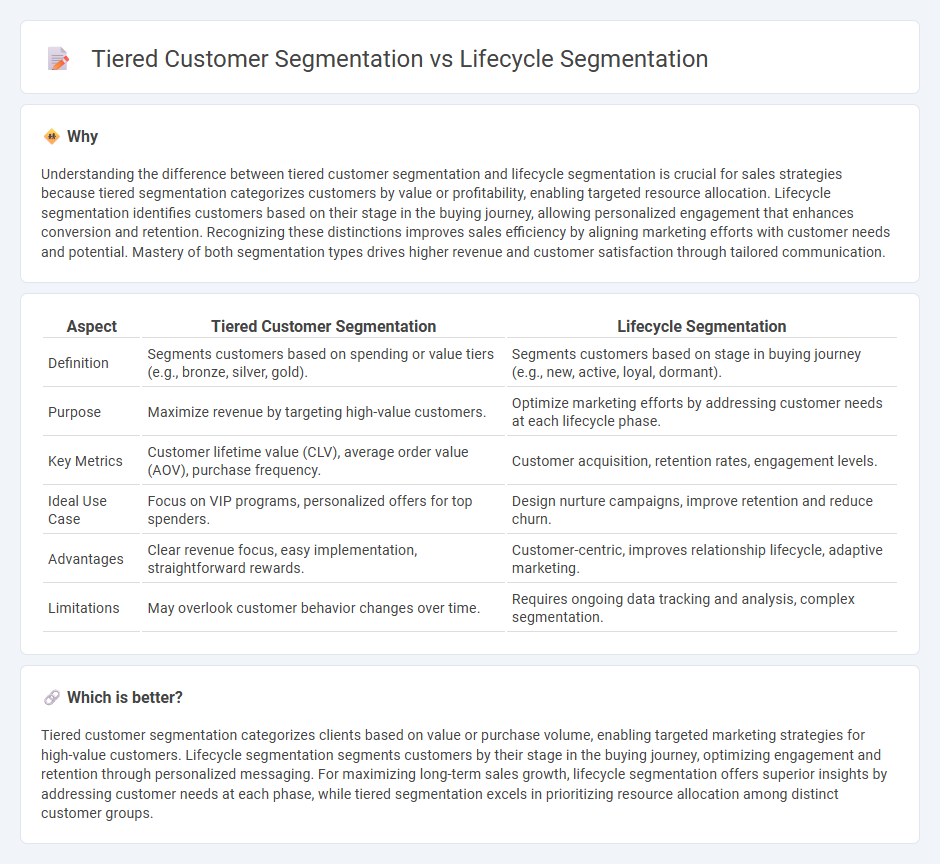
Tiered customer segmentation categorizes buyers based on revenue potential, dividing them into distinct groups to tailor sales strategies effectively. Lifecycle segmentation focuses on the customer's journey stage, enabling personalized engagement from acquisition to retention. Discover how these segmentation methods enhance sales performance and customer relationships.
Why it is important
Understanding the difference between tiered customer segmentation and lifecycle segmentation is crucial for sales strategies because tiered segmentation categorizes customers by value or profitability, enabling targeted resource allocation. Lifecycle segmentation identifies customers based on their stage in the buying journey, allowing personalized engagement that enhances conversion and retention. Recognizing these distinctions improves sales efficiency by aligning marketing efforts with customer needs and potential. Mastery of both segmentation types drives higher revenue and customer satisfaction through tailored communication.
Comparison Table
| Aspect | Tiered Customer Segmentation | Lifecycle Segmentation |
|---|---|---|
| Definition | Segments customers based on spending or value tiers (e.g., bronze, silver, gold). | Segments customers based on stage in buying journey (e.g., new, active, loyal, dormant). |
| Purpose | Maximize revenue by targeting high-value customers. | Optimize marketing efforts by addressing customer needs at each lifecycle phase. |
| Key Metrics | Customer lifetime value (CLV), average order value (AOV), purchase frequency. | Customer acquisition, retention rates, engagement levels. |
| Ideal Use Case | Focus on VIP programs, personalized offers for top spenders. | Design nurture campaigns, improve retention and reduce churn. |
| Advantages | Clear revenue focus, easy implementation, straightforward rewards. | Customer-centric, improves relationship lifecycle, adaptive marketing. |
| Limitations | May overlook customer behavior changes over time. | Requires ongoing data tracking and analysis, complex segmentation. |
Which is better?
Tiered customer segmentation categorizes clients based on value or purchase volume, enabling targeted marketing strategies for high-value customers. Lifecycle segmentation segments customers by their stage in the buying journey, optimizing engagement and retention through personalized messaging. For maximizing long-term sales growth, lifecycle segmentation offers superior insights by addressing customer needs at each phase, while tiered segmentation excels in prioritizing resource allocation among distinct customer groups.
Connection
Tiered customer segmentation categorizes buyers based on value or behavior, creating layers that reflect different profitability or engagement levels. Lifecycle segmentation tracks customers through stages like acquisition, retention, and churn, highlighting changing needs over time. Connecting both approaches enables targeted sales strategies that align tier-specific offers with lifecycle phases, maximizing revenue and customer loyalty.
Key Terms
Customer Journey Stages
Lifecycle segmentation categorizes customers based on their position in the customer journey stages, such as awareness, consideration, purchase, retention, and advocacy, enabling personalized marketing strategies tailored to each stage's needs. Tiered customer segmentation ranks customers by value, engagement, or profitability, often grouping them into high, mid, and low tiers to prioritize resource allocation and loyalty programs. Explore the differences and advantages of each approach to optimize customer engagement and maximize retention.
Account Value Tiers
Lifecycle segmentation categorizes customers based on their stage in the buying journey, while tiered customer segmentation groups accounts by value tiers such as platinum, gold, and silver based on their revenue potential or spending behavior. Account Value Tiers enable businesses to allocate resources effectively by targeting high-value customers with personalized offers and prioritizing retention efforts. Explore how leveraging Account Value Tiers can enhance your customer segmentation strategy and drive revenue growth.
Behavior-Based Grouping
Lifecycle segmentation categorizes customers based on distinct stages such as awareness, consideration, purchase, and retention, emphasizing temporal behavioral patterns. Tiered customer segmentation ranks customers by value or engagement levels, often using metrics like purchase frequency or spending, to prioritize marketing efforts. Explore how behavior-based grouping enhances targeted strategies by understanding customer actions in dynamic segments.
Source and External Links
Lifecycle Segmentation Definition | The SaaS Glossary by Upollo - Lifecycle segmentation is the practice of dividing customers into groups based on their stage in the journey with your product, enabling targeted messaging and experiences for each segment--from trial users to power users to churned customers.
Customer Lifecycle Segmentation: Examples, Strategies & Tools - Customer lifecycle segmentation organizes users by actions and timing in their journey (such as sign-up date, usage frequency, or recent activity), enabling more relevant, timely, and effective engagement compared to demographic segmentation.
Lifecycle Segmentation: From New Donors to Legacy Supporters - Lifecycle segmentation involves grouping donors by their phase in the donor journey (prospective, new, repeat, or legacy), which allows nonprofits to deliver personalized outreach and foster deeper, long-term engagement.
 dowidth.com
dowidth.com